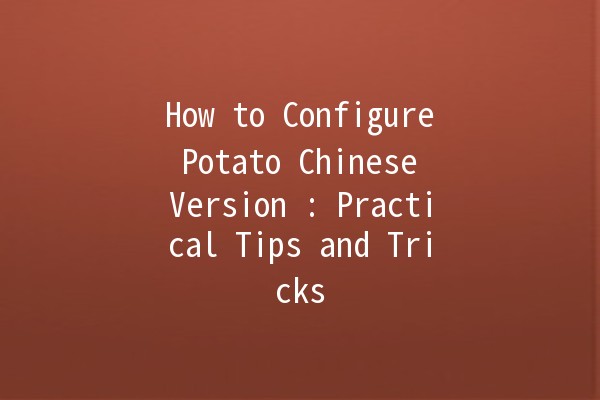In the realm of tech tools and software, efficient configuration is a key to maximizing productivity. This article explores how to properly set up the Potato Chinese version, offering practical strategies and insightful tips to enhance your experience. The goal here is not just to inform, but also to empower users to leverage Potato to its fullest potential. Below are some productivityenhancing strategies, followed by answers to common questions related to the configuration process.
Understanding Potato Configurations
Potato serves as a versatile application tool that can simplify various tasks, especially for users who prefer a Chinese interface. Configuring it correctly means you can optimize your workflow and make the best use of its features.
Why Configure?

Configuration allows you to tailor the software to meet your specific needs. When you personalize your settings, you enhance usability, increase efficiency, and improve your overall experience. Whether you're looking to streamline your tasks or improve your content management, a wellconfigured Potato can make a significant difference.
5 ProductivityEnhancing Tips for Potato Configuration
Here are five practical tips to optimize the Potato Chinese version configuration:
Explanation: Custom shortcuts can save you a significant amount of time. Instead of navigating through multiple menus, you can set keyboard shortcuts for frequently used functions.
Example: If you often need to insert specific templates or frequently accessed files, assign shortcuts (like Ctrl+Shift+T for templates) that can be executed easily.
Explanation: The visual aspect of an application can greatly influence your productivity. Utilizing theme settings that reduce eye strain can help maintain focus during lengthy work sessions.
Example: Switch to a softer color palette or a dark mode in Potato’s settings to reduce glare, thereby making it easier to work for extended periods without discomfort.
Explanation: Potato may offer integrations with other essential tools you use, such as cloud storage services, task management software, or communication platforms.
Example: Link your Google Drive to Potato, allowing you to access and save files directly from your preferred cloud service without needing to switch applications.
Explanation: As your work habits evolve, so should your application configurations. Regular updates to settings ensure that they align with your current processes and challenges.
Example: Every month or two, review your settings. If you find yourself using specific features less frequently, consider replacing them with others you utilize more often.
Explanation: Don’t reinvent the wheel. The Potato support community can offer a wealth of knowledge regarding best practices and unique configuration tips.
Example: Participate in community forums to learn how others configure their Potato setups for efficiency. Share your own tips to foster collaboration and build connections within the user community.
Common Questions About Configuring Potato Chinese Version
What are the basic requirements for installing Potato?
To install the Potato Chinese version, ensure your system meets the minimum requirements, typically including an operating system version, available storage space, and necessary network settings. Detailed specifications can usually be found on the Potato official website or within software documentation.
How do I restore default settings in Potato?
If you've experimented with different settings and want to revert to defaults, look for the "Reset to Default" option in the settings menu. This will clear all custom settings and restore the application to its original state, allowing you to start fresh.
Can I customize the user interface?
Absolutely! The Potato Chinese version allows significant customization of the user interface. Within the settings, you can modify menus, buttons, and even the positioning of various tools to suit your preferences.
What should I do if Potato crashes during configuration?
If Potato crashes, restart the application and try again. If the issue persists, consider checking the Potato support forums for similar complaints. Often, community members will have solutions or workarounds until an official patch is released.
How can I address compatibility issues with other software?
Compatibility issues can often be resolved by updating both the Potato application and the conflicting software. If problems continue, consult the help section in Potato or reach out to their support team for specific compatibility solutions.
Can Potato handle large files efficiently?
Yes, the Potato Chinese version is designed to manage a range of file sizes. However, keep in mind that performance can be affected by your device's specifications. For best results, ensure your device meets recommended performance criteria and regularly clear temporary files to maintain efficiency.
Configuring the Potato Chinese version optimally can greatly enhance your productivity and overall user experience. By implementing the outlined tips and understanding the answers to common questions, you’ll be well on your way to mastering Potato’s configuration. Enjoy utilizing the powerful features this software offers, and don’t forget to engage with the community for ongoing tips and support!